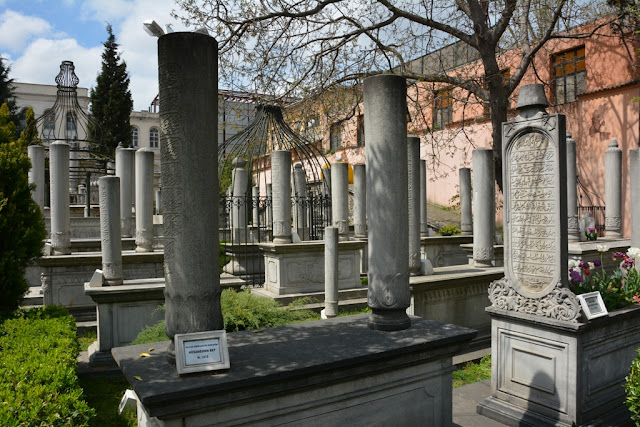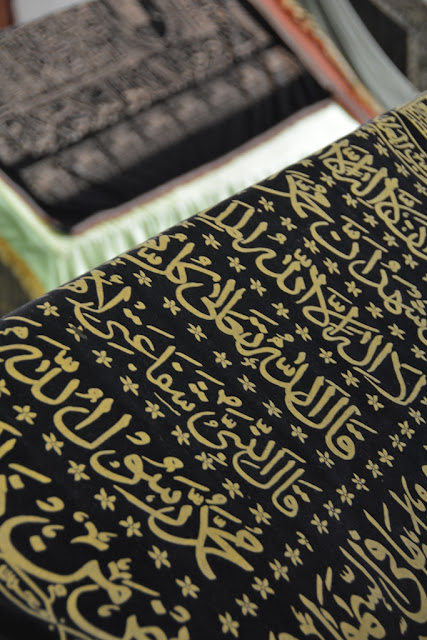On the Divanyolu Street, we saw a round monument with a dome and didn’t know what this was. It turned out to be the mausoleum of Sultan Mahmud II and his most important family members. We assume most of the people buried on the graveyard are also family because he had 17 wives and 44 children.
Sultan Mahmud II reigned from 1808 till 1839 and was very lucky he was still alive. He was the second brother in the family and he survived a murder attempt. In early harem traditions, only the oldest son could survive not to have disputes about the throne.
Inside his mausoleum, the coffins are above ground and the dome is spectacular. This is probably only the case for royals because according to Muslim tradition the graves should be simple.
In the graveyard you see many tombs with vertical columns. The highest column represents where the head of the deceased is and it faces the direction of the Kaäba in Mecca. The vertical stones represent the places where the angels land. Only on female graves it is common to put flowers.
Op Divanyolu straat zagen we een rond monument en wisten niet wat het was. Het bleek het mausoleum te zijn van Sultan Mahmud II en zijn belangrijkste familieleden. We veronderstellen dat vele mensen op dit kerkhof afstammelingen van deze Sultan zijn, daar hij 17 vrouwen en 44 kinderen had.
Sultan Mahmud II regeerde van 1808 tot 1839 en kon zich gelukkig prijzen nog in leven te zijn. Hij was de tweede broer in lijn voor de troon en overleefde een moordaanslag als kind. Volgens de vroegere harem tradities werden alle zonen na de troonopvolger vermoord om twisten binnen het rijk te vermijden.
Binnen in het mausoleum staan de graven bovengronds en de koepel is spectaculair. Deze is waarschijnlijk enkel zo voor koninklijke begraafplaatsen want volgens de moslim traditie dient het graf eenvoudig te zijn.
Op het kerkhof zie je vele graven met verticale zuilen op de grafsteen. De hoogste vertegenwoordigd de plaats van het hoofd van de overledene en kijkt in de richting van de Kaäba in Mekka. De twee verticale zuilen tonen ook de plaats aan waar engelen landen. Het is enkel gebruikelijk bloemen te plaatsen op vrouwelijke graven..
Previous Istanbul article:
Flowers and the Tulip Festival in Istanbul
Previous Cemetery article:
Petersfriedhof and the dark catacomben, Salzburg
Return to main page
Gouden bladeren – Golden leaves
11 hours ago
























Wonderful impressions of this special place. Wonderful details too. Gorgeous !
ReplyDeleteAmazing fotos from beautiful place.
ReplyDeleteWish you happy sunday evening.
orvokki
Reizen om te leren...
ReplyDeleteHelemaal anders dan bij ons, Filip... én luxueus...
Lie(f)s.
a lovely, peaceful resting place!!
ReplyDeletelike the tulips, they came from Turkey to NL btw...happy Sunday eve!
ReplyDeleteThese are quite unlike our graveyards! How interesting that they have landing places for angels!!! I love the ornate door!
ReplyDelete17 vrouwen en 44 kinderen pffff...drukke boel :)
ReplyDeletehet doet goed de foto's te zien, nice memories
ReplyDeleteDe graven in de kerk zien er heel apart uit, het lijken van een afstand net tentjes.
ReplyDeleteImagine ever having that many wives! It's often hard for many people to find one soul mate for life, but 17 different women? Wow...and then to add 44 children to your life as well..... It looks like a very interesting place to tour, and I like the flowers you included!
ReplyDelete•✰ •✰ •✰ •✰ •✰ •✰
ReplyDeleteBonjour Filip :o)
Je te remercie pour ces belles photos.
J'aime les fleurs.
bon dimanche début de semaine
BISOUS d'Asie !!!! :o)
•✰ •✰ •✰ •✰ •✰ •✰
Graveyards are fascinating places aren't they?
ReplyDeleteit is not so unlike our american cemeteries, yet a tomb or mausoleum sounds so somber and scary! :)
ReplyDeleteVery informative. Looks peaceful and lovely.
ReplyDeleteI like the idea of having a place for angels to land.
ReplyDeleteStrange place
ReplyDeleteFriendly ALOHA
from Waikiki
Comfort Spiral
~ > < } } ( ° > <3
> < } } ( ° >
vreemd toch hoe elke cultuur andere gewoontes heeft...
ReplyDeleteknappe foto's Filip
groeten
I always learn so much from your posts. I love the tomb and wowsa - 44 children! LOL Cemeteries always intrigue me anyway so this was a great tour thank you.
ReplyDeleteVery interesting info Filip. Always good to learn something new.
ReplyDeleteprachtig om kennis te maken met een ons onbekende cultuur!
ReplyDeleteinteressant verhaal en mooie serie Filip. Fijne avond, Dietmut
ReplyDeleteI am a Turkish woman interested in history. I loved the pictures very much and was pleased with your narration which introduces Turkey as objectively as possible.
ReplyDeleteBy the way, I have to correct one error that I have seen for a few times in your texts. You say that only the oldest son survived and the others were killed when they were born. It is not true! The emperors that reigned until Sultan Ahmet I had many sons from many women; they would receive training in harem until a certain age and then were sent to sanjaks to receive practical training about administration of the cities or provinces or regions under their responsibility. The purpose was to best train the one that would ascend the throne after the emperor. When the emperor died, mostly the one that was in the closest sanjak would arrive to Topkapı Palace and ascend the throne and then kill the rest. It was not allowed to kill brothers as long as the emperor was alive. Sultan Mehmed the Conqueror ordered in his books that after the death's of the emperor, the other ascending the throne was allowed to kill his brothers to avoid chaos and disorder among them. But in the reign of Sultan Ahmet (who saw the killings of 18 brother of his father including one of 8 months old when his father ascended the throne), he changed the system and ordered that the one that is the oldest and wisest would ascend the throne after the death of the emperor and the others would live in the palace, mostly under surveillance in locked rooms (of the emperor's fear of being killed by one of them). This is considered as one of the reasons that led to the decline of the empire because even those that became lunatic after being kept in locked rooms for long years ascended the throne and ruled the country badly under the influence of women and bad imperial council members.
But at one point, you are true. The emperor's favourite and strong women would sometimes kill the other women's male children secretly and it was difficult to protect your child from the ones that gave birth to the older ones. If the valide sultan (the mother of the emperor) supported you, your children would probably stay alive. In fact, the systematics of harem is more complicated; but I wanted to summarise it for you.
Thanks again for the lovely pictures and your interesting style of narration.
Thank you for your contributions, I hope many others could learn from it. I am very pleased knowledgable people are interested and comment to our travel blog.
ReplyDelete